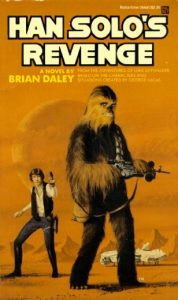Timothy Zahn’s Han Solo-centered “Scoundrels” was recently published, and like every book about the smuggler, his Wookiee sidekick and his faster-than-she-looks ship, it will have a high bar to clear. I’m probably not alone among “Star Wars” fans when I say that “Han Solo’s Revenge”(1979), the second book in Brian Daley’s “Han Solo Adventures” trilogy, is still the standard bearer among Solo novels.
This book was a breezy escape when I stole a chapter here and there in my high school library back in the ’90s. But it’s also complex enough that I had forgotten almost all of the details, and I enjoyed it even more on this re-reading. Just as he did with “Han Solo at Stars’ End,” Daley nails Han’s personality, values and ethics, along with the traits of Chewbacca and the Millennium Falcon. But “Han Solo’s Revenge” (which, honestly, has little to do with revenge) is a much better book, as the guest characters, strategies, set pieces, surprises and betrayals pop more.
As with many great yarns about operating on the fringe of the law (see TV’s “Firefly” as the high bar), Han and Chewie are thrown in with other folks whose goals intersect with his. “Team up” isn’t the right phrase, though; wisely, Han doesn’t trust anyone other than his first mate. We meet Fiolla, a potential love interest, and skip-tracer (read: tax collector) Spray, both of whom work for Han’s nemesis, the Corporate Sector Authority, but claim they want to clean it up from the inside. Han is so short on cash that he takes on an iffy job: He’s tasked to transport slaves — something that’s outside of his acceptable zone of morals — and he gets scammed. Now he just wants his 10,000 credits — and somebody’s gonna pay.
We also meet Gallandro, Han’s rival gunslinger, but while I had remembered a big shootout in this book, it actually happens in the trilogy capper, “Han Solo and the Lost Legacy.” That’s the showdown that daughter Anja Gallandro refers to in the “Young Jedi Knights” books that I recently reviewed.
Daley nicely illustrates that independent operators like Han have to have a flexible job description: In the opening chapter, he makes some cash by screening a basic documentary film for a species for whom projected images are like magic. (This ends up backfiring in a funny way, natch.)
I like how details about Han and Chewie’s problems of the moment naturally flow into the adventure rather than being too technical — here, they are frustrated that they had to outfit the Falcon with fluidics (or “damn fluidics,” as Han often says) rather than shielded circuitry.
Daley’s description of Chewie’s tactics for getting out of one scrape is pure poetry:
In the course of a long life Chewbacca had learned that there come times when the most bellicose roar is insufficient. He clamped one vast paw on either of Spray’s shoulders and effortlessly hoisted the skip-tracer up close, until their gazes were level. Suspended furry muzzle to bucktoothed muzzle with Chewbacca, his webbed feet dangling somewhere close to the Wookiee’s knees, the Tynnan watched as the Millennium Falcon’s first mate wordlessly peeled his lips back from ferocious rows of teeth.

Daley introduces a handful of characters, planets and concepts here that will feature in future “Star Wars” yarns, and often these introductions are more compelling in this early book (only the first movie had been released at this point) because he can’t get away with cutting corners. So Daley describes aliens rather than just naming their species and knowing that fans will understand. And his swoop chase seems more evocatively dangerous than is the norm, perhaps because it’s the first swoop chase chronicled in “Star Wars” lore.
The two major locations are Bonadan, a structured CSA spaceport, and Ammuud, which is less modernized. In one example of Daley’s quick-but-perfect character touches, Han reflects on the two locales:
For all its faults and imperfections, Han preferred an open, brawling and vital place like Ammuud to the depressing functionality of a Bonadan or the groomed sterility of one of the Authority’s capitol worlds. The place might never be awash in profit or influential in galactic affairs, but it looked like an interesting place to live.
Some might debate whether pulpy sci-fi adventures that weigh in at less than 200 pages qualify as an art form. If they do, “Han Solo’s Revenge” is a pretty much perfect example of the form — not because if its groomed sterility, but because it’s an interesting place to live for all of its 180 pages.
Comments
![]() Came across your blog while searching for the book by front cover. I too remember it from my high school days (and wonder where my Mom may be storing it). My son is 9 so I was nostalgically looking for some of the retro stuff I had read. Enjoyed your take and your recommend! I will have to get him a copy to read. 🙂# Posted By Chris | 1/14/13 10:58 PM
Came across your blog while searching for the book by front cover. I too remember it from my high school days (and wonder where my Mom may be storing it). My son is 9 so I was nostalgically looking for some of the retro stuff I had read. Enjoyed your take and your recommend! I will have to get him a copy to read. 🙂# Posted By Chris | 1/14/13 10:58 PM
![]() Thanks for the comment. If you can’t find your copy, it can be purchased cheaply on Amazon, as can the other two Solo books of course. The Daley books are great and definitely worth revisiting every decade or so.# Posted By John Hansen | 1/15/13 1:17 AM
Thanks for the comment. If you can’t find your copy, it can be purchased cheaply on Amazon, as can the other two Solo books of course. The Daley books are great and definitely worth revisiting every decade or so.# Posted By John Hansen | 1/15/13 1:17 AM
![]() I kind of disregard Brian Daley’s Han Solo trilogy as part of the Start Wars E.U. Why? I’m unsure, probably because it’s pre Timothy Zahn. Maybe more fool me. I have an old copy of The Lost Legacy, might be time I picked it up and gave it a try.# Posted By Frank O’Sullivan | 1/29/13 5:53 PM
I kind of disregard Brian Daley’s Han Solo trilogy as part of the Start Wars E.U. Why? I’m unsure, probably because it’s pre Timothy Zahn. Maybe more fool me. I have an old copy of The Lost Legacy, might be time I picked it up and gave it a try.# Posted By Frank O’Sullivan | 1/29/13 5:53 PM
![]() There are some very rare moments where it doesn’t line up with the EU, like the rare Clone Wars reference or calling the language Standard instead of Basic. But mostly they fit very nicely with EU canon and in fact the later books picked up a surprising amount of stuff from Daley, including the Corporate Sector, swoop racing, Z-95 Headhunters, and more.# Posted By John Hansen | 1/29/13 6:27 PM
There are some very rare moments where it doesn’t line up with the EU, like the rare Clone Wars reference or calling the language Standard instead of Basic. But mostly they fit very nicely with EU canon and in fact the later books picked up a surprising amount of stuff from Daley, including the Corporate Sector, swoop racing, Z-95 Headhunters, and more.# Posted By John Hansen | 1/29/13 6:27 PM

